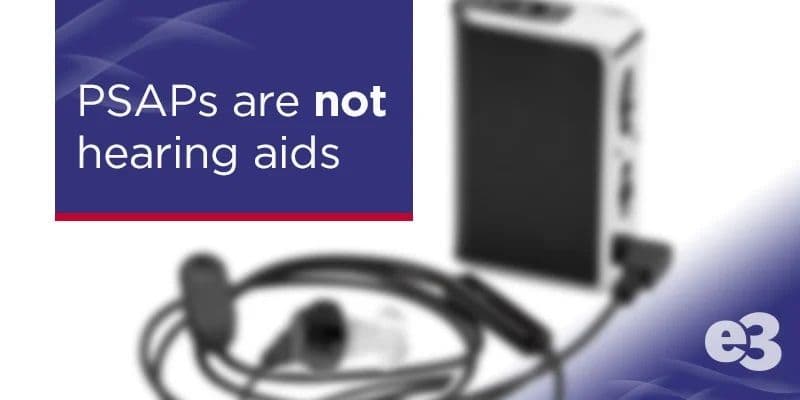The Difference Between PSAPs and Hearing Aids

The Food and Drug Administration (FDA) entered the Hearing Aids vs. Personal Sound Amplification Products debate by distinguishing the intended uses of the two devices. In its determination, the FDA classified hearing aids as “medical devices” and PSAPs as “electronic products.”
The agency then stated hearing aids are “appropriately used for difficulty hearing a person nearby; hearing conversation in crowded rooms; understanding movie dialog in a theater; listening to lectures in a quiet room; hearing the doorbell or phone; and understanding speech where environmental noise can interfere.”
PSAPs, on the other hand, were deemed by the FDA to be useful for “hearing a distant lecturer or conversation; listening for prey while hunting; hearing bird sounds; and listening to soft sounds that normal hearers would find difficult to hear.”
When patients of yours have to decide on selecting a hearing device, it’s critical to reference these differences so they understand the two devices are not the same.
Cost Should Never Be the Deciding Factor
Patients may bemoan that hearing aids are a considerable expense and medical insurance often does not cover the costs. They see a personal sound amplification product as an alternative that’ll “get the job done.” As an audiologist, you can reiterate that PSAPs are not subject to FDA requirements. This means that any marketing claims made by their manufacturers are not subject to government scrutiny and are, for the most part, largely unproven. In other words, when purchasing a budget-friendly PSAP, the transaction falls under the category of “you get what you pay for.”
Hearing aids sales are state regulated which mandate a return policy of 30 days or more. Unregulated PSAP sales may not come with any money-back guarantee.
Just the Facts
Back in 2013, the FDA updated its definitions of hearing aids and PSAPs. A hearing aid was defined as “a wearable sound-amplifying device that is intended to compensate for impaired hearing.” A PSAP was described as a “wearable electronic product that is NOT intended to compensate for impaired hearing.”
You can emphasize to your patients that hearing aids, need to be fit by an audiologist in order to program and optimize their performance. PSAPs can be ordered online or bought off the shelf with no professional set-up or guidance.
Hearing aids are programmable, so you can address an individual’s degree of hearing loss across various sound frequencies in order to improve speech intelligibility. Personal sound amplification products are ready for use “as is” right out of their packaging.
Hearing aids can be coupled to external electronic products such as MP3 players, televisions, and both landline and mobile phones. PSAPs are simply sound amplification devices with fewer features and a lack of functionality.
It isn’t just about loudness
The main purpose of a PSAP is make sounds loud in certain environments. When a patient believes that is all they need to hear better, you need to advise them that treating hearing loss is more intricate and complicated than just cranking up the volume. Let them know that a person with a normal auditory system can filter out ambient noise and concentrate on specific sounds they want to hear. Hearing aids help to replicate this auditory function for those with hearing damage.
Customized output limits ensure that sound is not delivered to the wearer’s ear at a level that is high enough to potentially cause further damage. PSAPs do not have the capability of differentiating one sound from another. Everything including background noise, voices, and other sounds are all just made louder and the wearer could be subjected to further hearing impairment.
A Good Rule of Thumb
Only a complete professional evaluation can determine why a patient is not hearing well. Once test results are analyzed, you can help your patients decide which hearing aid is best for their lifestyle, their overall hearing health, and their budget. As for that rule of thumb, you know what it is, and you should pass it on to your patients: Never buy any hearing loss product unless it requires fitting by a hearing care professional.
